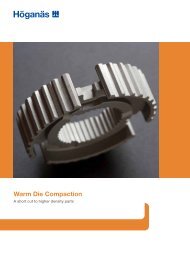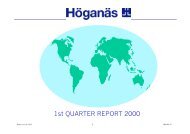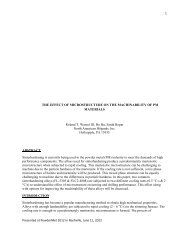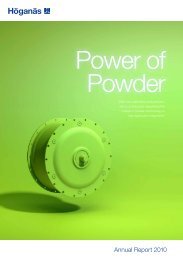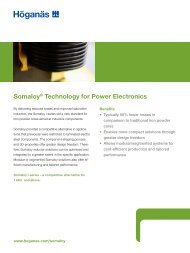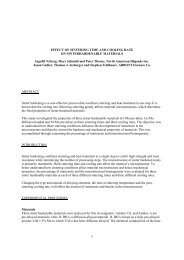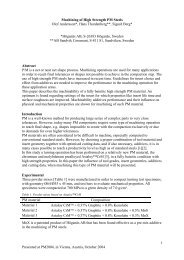high density pm components by high velocity ... - Höganäs AB
high density pm components by high velocity ... - Höganäs AB
high density pm components by high velocity ... - Höganäs AB
You also want an ePaper? Increase the reach of your titles
YUMPU automatically turns print PDFs into web optimized ePapers that Google loves.
Table 2. Approximate max densities achieved <strong>by</strong> HVC<br />
Process Density (g/cm³)<br />
HVC 7.4<br />
HVC+DWL<br />
HVC+WC+DWL<br />
7.6<br />
7.7<br />
HVC (P2S2) 7.8<br />
Potential applications for HVC exist both in the automotive industry and in other areas where P/M has not<br />
yet been established. Examples of potential applications are: valve seats, valve guides, main bearing caps,<br />
hubs, gears [8,10], flanges, connecting rods, cam lobes, bushings and bearing races. See Figure 5.<br />
Figure 5. Left: Gear for High Velocity Compaction - courtesy of Cloyes Gears & Products Inc., USA<br />
Right: Gerotor for High Velocity Compaction - courtesy of Hawk Precision Components, USA<br />
Recent R&D in the area of High Velocity Compaction [9] concludes that the major advantages HVC can<br />
offer are: <strong>high</strong> <strong>density</strong>, the capability to compact very large parts, and the possibility to produce <strong>high</strong><br />
numbers of parts in a short time.<br />
V. COMPARISON OF PROCESSING COSTS<br />
Processes that can offer improved material properties with no or moderate increase in manufacturing costs<br />
are of particular interest to the automotive industry, since they can expand the use of P/M applications in<br />
cars and reduce the total cost for the end user.<br />
The approximate relative processing cost for various P/M processes, using conventional single pressing as<br />
a reference, is presented in Figure 6. Production methods that only involve a few processing steps, have a<br />
<strong>high</strong> production capacity and require a minimum of investment for the equi<strong>pm</strong>ent are of special interest.<br />
This applies particularly if net shape or near net shape parts can be produced as a result of good tolerances<br />
and surface finish.<br />
A good cost/performance ratio explains why the conventional compaction method is the most established<br />
and most frequently used. This also explains the recent success of warm compaction, which is increasingly<br />
used and has now spread worldwide.<br />
6



